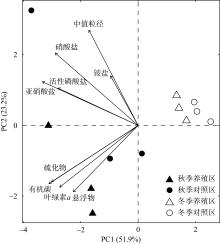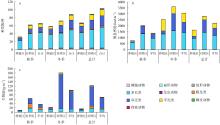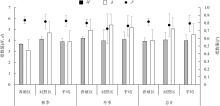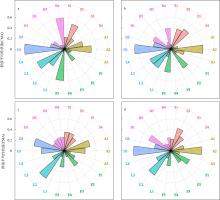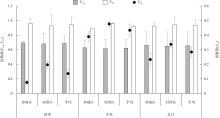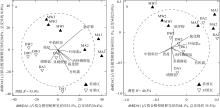Journal of Tropical Oceanography ›› 2024, Vol. 43 ›› Issue (5): 69-83.doi: 10.11978/2023146CSTR: 32234.14.2023146
• Marine Biology • Previous Articles Next Articles
Influence of raft-string oyster culture on the functional structure of macrobenthic communities: a case study in the Dapeng Cove*
RAO Yiyong1,2( ), ZHAO Meirong1, KUANG Zexing1, HUANG Honghui1,2(
), ZHAO Meirong1, KUANG Zexing1, HUANG Honghui1,2( ), TAN Erhui3
), TAN Erhui3
- 1. South China Sea Fisheries Research Institute, Chinese Academy of Fishery Sciences, Guangzhou 510300, China
2. Guangdong Provincial Key Laboratory of Fishery Ecology and Environment, Guangzhou 510300, China
3. State Key Laboratory of Marine Resource Utilization in South China Sea, Hainan University, Haikou 570228, China
-
Received:2023-10-10Revised:2023-10-31Online:2024-09-10Published:2024-10-10 -
Supported by:National Natural Science Foundation of China(42206119); Open Project of State Key Laboratory of Marine Resource Utilization in South China Sea, Hainan University(MRUKF202101); Central Public-interest Scientific Institution Basal Research Fund, South China Sea Fisheries Research Institute, CAFS(2020TS02); Fujian Provincial Social Science Foundation Youth Project(FJ2021C083)
Cite this article
RAO Yiyong, ZHAO Meirong, KUANG Zexing, HUANG Honghui, TAN Erhui. Influence of raft-string oyster culture on the functional structure of macrobenthic communities: a case study in the Dapeng Cove*[J].Journal of Tropical Oceanography, 2024, 43(5): 69-83.
share this article
Add to citation manager EndNote|Reference Manager|ProCite|BibTeX|RefWorks
Tab. 1
Analysis methods and detection limits of environmental variables"
| 检测要素 | 检测标准(方法) | 检出限 | 仪器设备名称及型号 |
|---|---|---|---|
| 悬浮物 | 海洋监测规范 第4部分: 海水分析GB 17378.4-2007 (重量法) | 0.8mg·L-1 | 分析天平XS205 |
| 亚硝酸盐 | 海洋监测规范 第4部分: 海水分析GB 17378.4-2007 (萘乙二胺分光光度法) | 0.0003mg·L-1 | 紫外分光光度计UV-7504 |
| 硝酸盐 | 海洋监测规范 第4部分: 海水分析GB 17378.4-2007 (镉柱还原法) | 0.003mg·L-1 | 紫外分光光度计UV-7504 |
| 铵盐 | 海洋监测规范 第4部分: 海水分析GB 17378.4-2007 (靛酚蓝分光光度法) | 0.0009mg·L-1 | 紫外分光光度计UV-7504 |
| 活性磷酸盐 | 海洋监测规范 第4部分: 海水分析GB 17378.4-2007 (磷钼蓝分光光度法) | 0.0005mg·L-1 | 紫外分光光度计UV-7504 |
| 叶绿素a | 海洋监测规范 第7部分: 近海污染生态调查和生物监测GB 17378.7-2007 (荧光分光光度法) | / | TURNER10-AU现场荧光仪 |
| 中值粒径 | 激光衍射法 | 0.02μm | Mastersizer 2000G 激光粒度分析仪 |
| 有机碳 | 海洋监测规范 第5部分: 沉积物分析GB 17378.5-2007 (重铬酸钾氧化-还原容量法) | 0.3mg·kg-1 | 紫外分光光度计UV-7504 |
| 硫化物 | 海洋监测规范 第5部分: 沉积物分析GB 17378.5-2007 (亚甲基蓝分光光度法) | 0.01% | 滴定管 |
Tab. 2
Traits and relevant functional attributes of macrobenthic fauna"
| 性状 | 性状类别 | 代码 | 功能属性 |
|---|---|---|---|
| 个体大小 | 极小 (<1cm) | S1 | 个体大小对生产力、栖息地的结构和增益程度具有直接影响, 并对沉积物-水界面的氧气和养分通量产生重要影响。并与生态系统的食物网结构、营养级和能流有关(Bolam et al, |
| 小 (1~3cm) | S2 | ||
| 中 (3~10cm) | S3 | ||
| 大 (>10cm) | S4 | ||
| 个体寿命 | 短 (<1a) | A1 | 反映生物受到扰动的恢复力, 寿命长的生物需要更长的时间来恢复, 而寿命短的生物可以快速恢复, 并可能随着干扰的增加而增多(Bolam et al, |
| 中 (1~3a) | A2 | ||
| 长 (>3a) | A3 | ||
| 摄食类型 | 悬浮食性 | F1 | 指示水动力条件, 例如悬浮食性生物一般生活于急流中; 影响氧气的渗透、资源的利用、有机物的分解和养分的循环/再生; 对群落中其他物种的控制作用(Bremner, |
| 沉积食性 | F2 | ||
| 植食性 | F3 | ||
| 腐食性 | F4 | ||
| 捕食性 | F5 | ||
| 栖息习性 | 管栖 | L1 | 栖息习性对沉积物的生物地球化学循环具有直接影响, 同时, 栖息习性不同的生物对捕食和扰动具有不同的响应, 如附着生物易受捕食; 穴居和管栖的生物受缺氧环境影响较小(Bremner, |
| 穴居 | L2 | ||
| 自由生活 | L3 | ||
| 附着 | L4 | ||
| 幼体发育 | 营浮游发育 | D1 | 物种扩散、入侵或从种群减少中恢复的能力。通常营浮游发育的物种的扩散能力要高于底栖直接发育的物种(Bolam et al, |
| 底栖直接发育 | D2 | ||
| 生物扰动 | 底表沉积 | B1 | 影响沉积物的生物地球化学循环和理化性质(沉积物粒径、氧化还原电位等) (Queirós et al, |
| 向上传输 | B2 | ||
| 向下传输 | B3 | ||
| 扩散混合 | B4 |
Tab. 3
Mean values and standard deviations of the environmental variables in the raft-string oyster culture zone and its adjacent waters in the Dapeng Cove"
| 环境因子 | 秋季 | 冬季 | |||
|---|---|---|---|---|---|
| 养殖区 | 对照区 | 养殖区 | 对照区 | ||
| 水环境 | 叶绿素a /(mg·m-3) | 2.98 (1.06) | 2.64 (0.14) | 0.88 (0.29) | 0.93 (0.15) |
| 悬浮物/(mg·L-1) | 16.3 (2.2) | 8.9 (2.2) | 8.7 (0.4) | 8.7 (0.5) | |
| 亚硝酸盐/(mg·L-1) | 0.0028 (0.0007) | 0.0027 (0.0025) | 0.0012 (0.0002) | 0.0003 (0.0004) | |
| 硝酸盐/(mg·L-1) | 0.097 (0.048) | 0.181 (0.192) | 0.033 (0.003) | 0.021 (0.012) | |
| 铵盐/(mg·L-1) | 0.020 (0.020) | 0.014 (0.009) | 0.026 (0.008) | 0.011 (0.003) | |
| 活性磷酸盐/(mg·L-1) | 0.0061 (0.0029) | 0.0055 (0.0013) | 0.0041 (0.0006) | 0.0039 (0.0010) | |
| 沉积环境 | 有机碳/% | 2.83 (0.18) | 2.19 (0.05) | 1.37 (0.11) | 0.67 (0.07) |
| 硫化物/(mg·kg-1) | 484.33 (73.11) | 461.67 (141.55) | 10.20 (10.53) | 7.41 (2.04) | |
| 中值粒径/μm | 10.44 (1.02) | 40.30 (37.75) | 11.48 (1.04) | 17.95 (2.65) | |
Tab. 4
Dominant species contributing to the dissimilarities of macrobenthic communities in the raft-string oyster culture zone and its adjacent waters in the Dapeng Cove"
| 类群 | 种名 | 季节间 | 区域间 | ||||
|---|---|---|---|---|---|---|---|
| 栖息密度/(ind·m-2) | 贡献度/% | 栖息密度/(ind·m-2) | 贡献度/% | ||||
| 秋季 | 冬季 | 养殖区 | 对照区 | ||||
| 多毛类 | 背褶沙蚕 Tambalagamia fauveli | 95 | 15 | 2.4 | 102 | 8 | 3.0 |
| 才女虫 Polydora sp. | 5 | 42 | 1.9 | 27 | 20 | 1.3 | |
| 寡节甘吻沙蚕 Glycinde gurjanovae | 75 | 158 | 2.2 | 62 | 172 | 2.4 | |
| 寡鳃齿吻沙蚕 Nephtys oligobranchia | 23 | 98 | 2.1 | 50 | 72 | 1.7 | |
| 花冈钩毛虫 Sigambra hanaokai | 158 | 158 | 2.0 | 143 | 173 | 2.3 | |
| 滑指矶沙蚕 Eunice indica | 62 | 67 | 1.5 | 38 | 90 | 1.7 | |
| 角海蛹 Ophelina acuminate | 10 | 55 | 2.0 | 38 | 27 | 1.4 | |
| 欧努菲虫 Onuphis eremita | 42 | 47 | 2.0 | 0 | 88 | 3.5 | |
| 蛇杂毛虫 Poecilochaetus serpens | 35 | 25 | 1.8 | 10 | 50 | 1.8 | |
| 梳鳃虫 Terebellides stroemii | 50 | 73 | 2.4 | 90 | 33 | 2.4 | |
| 树蛰虫 Pista cristata | 7 | 117 | 2.5 | 7 | 117 | 2.5 | |
| 细丝鳃虫 Cirratulus filiformis | 118 | 130 | 1.9 | 95 | 153 | 1.8 | |
| 持真节虫 Euclymene annandalei | 42 | 15 | 4.5 | 3 | 53 | 2.1 | |
| 稚齿虫 Prionospi sp. | 8 | 125 | 3.2 | 98 | 35 | 2.3 | |
| 双壳类 | 安汶圆蛤 Cycladicama amboinensis | 123 | 22 | 1.7 | 15 | 130 | 2.1 |
| 波纹螂斗蛤 Myadora fluctuosa | 3 | 42 | 2.0 | 17 | 28 | 1.5 | |
| 粗帝汶蛤 Timoclea scabra | 22 | 603 | 5.4 | 30 | 595 | 5.2 | |
| 虹光亮樱蛤 Nitidotellina iridella | 150 | 33 | 2.3 | 15 | 168 | 2.7 | |
| 理蛤 Theora lata | 27 | 27 | 1.5 | 43 | 10 | 2.2 | |
| 甲壳类 | 巴西地钩虾 Podocerus brasiliensis | 0 | 292 | 4.8 | 242 | 50 | 3.2 |
| 蜾蠃蜚 Corophium sp. | 0 | 47 | 1.7 | 47 | 0 | 1.4 | |
| 宽甲古涟虫 Eucoma lata | 2 | 67 | 1.9 | 0 | 68 | 2.0 | |
| 六齿拟钩虾 Gammaropsis sexdentata | 37 | 197 | 3.6 | 218 | 15 | 4.0 | |
| 双眼钩虾 Ampelisca sp. | 2 | 133 | 2.9 | 0 | 135 | 3.0 | |
| 平均相异性 /% | 61.6 | 62.0 | |||||
Tab. 5
Dominant trait modalities contributing to the dissimilarities of trait composition of macrobenthic communities in the raft-string oyster culture zone and its adjacent waters in the Dapeng Cove"
| 性状 | 性状类别 | 季节间 | 区域间 | ||||
|---|---|---|---|---|---|---|---|
| 群落加权平均性状值 | 贡献度/% | 群落加权平均性状值 | 贡献度/% | ||||
| 秋季 | 冬季 | 养殖区 | 对照区 | ||||
| 个体大小 | S1 (极小个体) | 0.15 | 0.29 | 5.2 | 0.29 | 0.15 | 5.6 |
| S2 (小个体) | 0.44 | 0.39 | 5.4 | 0.42 | 0.42 | 5.8 | |
| S3 (中等个体) | 0.35 | 0.31 | 4.4 | 0.27 | 0.39 | 5.5 | |
| S4 (大个体) | 0.05 | 0.02 | 1.2 | 0.03 | 0.04 | 0.9 | |
| 个体寿命 | A1 (短寿命) | 0.25 | 0.37 | 6.3 | 0.42 | 0.19 | 7.9 |
| A2 (中等寿命) | 0.56 | 0.49 | 5.1 | 0.45 | 0.59 | 5.7 | |
| A3 (长寿命) | 0.20 | 0.14 | 2.6 | 0.13 | 0.21 | 3.3 | |
| 摄食类型 | F1 (悬浮食性) | 0.12 | 0.31 | 6.2 | 0.17 | 0.26 | 5.7 |
| F2 (沉积食性) | 0.35 | 0.31 | 3.5 | 0.31 | 0.35 | 4.0 | |
| F3 (极小个体) | 0.01 | 0.09 | 2.3 | 0.07 | 0.03 | 2.0 | |
| F4 (腐食性) | 0.01 | 0.00 | 0.2 | 0.00 | 0.01 | 0.2 | |
| F5 (捕食性) | 0.51 | 0.29 | 7.4 | 0.45 | 0.36 | 5.9 | |
| 栖息习性 | L1 (管栖) | 0.10 | 0.14 | 2.2 | 0.09 | 0.15 | 2.7 |
| L2 (穴居) | 0.40 | 0.58 | 6.9 | 0.50 | 0.48 | 6.6 | |
| L3 (自由生活) | 0.49 | 0.27 | 8.0 | 0.40 | 0.36 | 6.6 | |
| L4 (附着) | 0.01 | 0.01 | 0.4 | 0.01 | 0.00 | 0.4 | |
| 幼体发育 | D1 (营浮游发育) | 0.71 | 0.56 | 6.2 | 0.58 | 0.68 | 6.0 |
| D2 (底栖直接发育) | 0.29 | 0.44 | 6.2 | 0.42 | 0.32 | 6.0 | |
| 生物扰动 | B1 (底表沉积) | 0.30 | 0.34 | 5.3 | 0.23 | 0.41 | 6.6 |
| B2 (向上传输) | 0.10 | 0.21 | 3.6 | 0.17 | 0.13 | 2.8 | |
| B3 (向下传输) | 0.11 | 0.20 | 3.2 | 0.17 | 0.14 | 3.1 | |
| B4 (扩散混合) | 0.49 | 0.25 | 8.3 | 0.42 | 0.32 | 6.7 | |
| 平均相异性/% | 27.1 | 25.2 | |||||
| [1] |
白美娜, 江涛, 陈飞羽, 等, 2019. 大亚湾大鹏澳牡蛎养殖临近海域自养微微型浮游生物种群分布特征[J]. 海洋与湖沼, 50(1): 129-138.
|
|
|
|
| [2] |
蔡立哲, 2003. 大型底栖动物污染指数(MPI)[J]. 环境科学学报, 23(5): 625-629.
|
|
|
|
| [3] |
邓邦平, 杨宇峰, 2011. 大鹏澳养殖海域表底层水环境及浮游动物群落结构的比较研究[J]. 海洋环境科学, 30(4): 492-495.
|
|
|
|
| [4] |
中华人民共和国国家质量监督检验检疫总局, 中国国家标准化管理委员会, 2007a. GB/T12963-2007海洋调查规范[S]. 北京: 中国标准出版社 (in Chinese).
|
| [5] |
中华人民共和国国家质量监督检验检疫总局, 中国国家标准化管理委员会, 2007b. GB/T17378-2007海洋监测规范[S]. 北京: 中国标准出版社 (in Chinese).
|
| [6] |
齐占会, 王珺, 黄洪辉, 等, 2012. 广东省海水养殖贝藻类碳汇潜力评估[J]. 南方水产科学, 8(1): 30-35.
|
|
|
|
| [7] |
于宗赫, 江涛, 夏建军, 等, 2014. 大鹏澳牡蛎养殖区生态服务价值评估[J]. 水产学报, 38(6): 853-860.
|
|
|
|
| [8] |
张玲, 李政菊, 陈飞羽, 等, 2015. 大鹏澳牡蛎养殖对浮游植物种群结构的影响研究[J]. 海洋与湖沼, 46(3): 549-555.
|
|
|
|
| [9] |
朱骅, 2019. 从碳汇渔业到蓝色粮仓的发展机制[J]. 上海海洋大学学报, 28(6): 968-975.
|
|
|
|
| [10] |
pmid: 16862294 |
| [11] |
|
| [12] |
doi: 10.1038/s41598-017-13263-w pmid: 29030563 |
| [13] |
|
| [14] |
|
| [15] |
|
| [16] |
|
| [17] |
doi: 10.1016/j.marpolbul.2010.07.024 pmid: 20825954 |
| [18] |
|
| [19] |
pmid: 24649641 |
| [20] |
doi: 10.2134/jeq2019.03.0099 |
| [21] |
|
| [22] |
|
| [23] |
|
| [24] |
|
| [25] |
|
| [26] |
|
| [27] |
|
| [28] |
|
| [29] |
doi: 10.1038/s41597-019-0344-7 pmid: 31913312 |
| [30] |
doi: 10.1146/annurev-marine-010814-020007 pmid: 25251269 |
| [31] |
doi: S0025-326X(19)30250-4 pmid: 31232327 |
| [32] |
|
| [33] |
|
| [34] |
|
| [35] |
|
| [36] |
|
| [37] |
doi: 10.1016/j.marenvres.2009.04.001 pmid: 19409610 |
| [38] |
doi: S0025-326X(19)30526-0 pmid: 31426174 |
| [39] |
doi: 10.1002/ece3.769 pmid: 24198953 |
| [40] |
|
| [41] |
pmid: 16038944 |
| [42] |
|
| [43] |
|
| [44] |
|
| [45] |
|
| [46] |
|
| [47] |
|
| [48] |
doi: 10.1890/07-1206.1 pmid: 18724739 |
| [1] | XU Lijia, LIAO Zhiheng, CHEN Hui, WANG Yongzhi, HUANG Baiqiang, LIN Qiaoyun, GAN Jianfeng, YANG Jing. Community structure of scleractinian corals in the northern South China Sea and their responses to the marine heatwaves [J]. Journal of Tropical Oceanography, 2024, 43(3): 58-71. |
| [2] | CHEN Junqiang, WANG Wenbo, WANG Qing, YANG Yufeng. Species diversity and habitat preference of bdelloid rotifers in the Weizhou island, Guangxi [J]. Journal of Tropical Oceanography, 2024, 43(2): 81-91. |
| [3] | HAN Minmin, LI Mi, LIU Xinming, LIU Yonghong, LONG Chao, ZHONG Zhenguo, YI Xiangxi, GAO Chenghai. Studies on bacterial diversity in coral reef sediments in Khai Island and Pathiu Island and bacterial crude extract retards aging activity of Caenorhabditis elegans* [J]. Journal of Tropical Oceanography, 2020, 39(5): 19-29. |
| [4] | CHEN Wen-he,LIU Xue-dong,LU Huo-sheng. Research on seasonal changes of the fish structure community in Nansha Islands waters [J]. Journal of Tropical Oceanography, 2010, 29(4): 118-124. |
|
||




